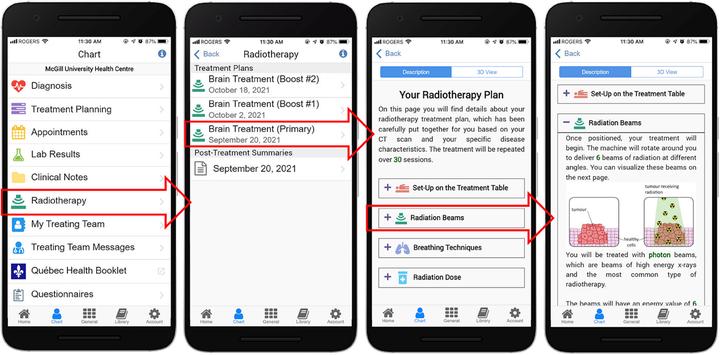 Image credit: Kayla O’Sullivan-Steben
Image credit: Kayla O’Sullivan-StebenAbstract
Purpose—Radiotherapy patients often face undue anxiety due to misconceptions about radiation and their inability to visualize their upcoming treatments. Access to their personal treatment plans is one way in which pre-treatment anxiety may be reduced. But radiotherapy data are quite complex, requiring specialized software for display and necessitating personalized explanations for patients to understand them. Therefore, our goal was to design and implement a novel radiotherapy menu in a patient portal to improve patient access to and understanding of their radiotherapy treatment plans. Methods—A prototype radiotherapy menu was developed in our institution’s patient portal following a participatory stakeholder co-design methodology. Customizable page templates were designed to render key radiotherapy data in the portal’s patient-facing mobile phone app. DICOM-RT data were used to provide patients with relevant treatment parameters and generate pre-treatment 3D visualizations of planned treatment beams, while the mCODE data standard was used to provide post-treatment summaries of the delivered treatments. A focus group was conducted to gather initial patient feedback on the menu. Results—Pre-treatment- the radiotherapy menu provides patients with a personalized treatment plan overview, including a personalized explanation of their treatment, along with an interactive 3D rendering of their body, and treatment beams for visualization. Post-treatment: a summary of the delivered radiotherapy is provided, allowing patients to retain a concise personal record of their treatment that can easily be shared with future healthcare providers. Focus group feedback was overwhelmingly positive. Patients highlighted how the intuitive presentation of their complex radiotherapy data would better prepare them for their radiation treatments. Conclusions—We successfully designed and implemented a prototype radiotherapy menu in our institution’s patient portal that improves patient access to and understanding of their radiotherapy data. We used the mCODE data standard to generate post-treatment summaries in a way that is easily shareable and interoperable.